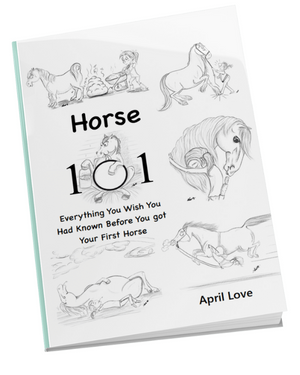Freezing temperatures and snow bring several misconceptions on how we care for our horses. In this article, April Love examines five common winter horse care myths, and what horse owners need to know.
Let’s take a look at some commonly held misconceptions.
“It’s cold, so I better blanket my horse!”
If you are not going to be riding your horse often or hard enough to generate a lot of sweat, you should let them ‘hair up’ as this helps trap in their own body heat providing them warmth when they ‘fluff up’. If you are in a very rainy part of the country where the hair will be laying down flat, they will require more energy to stay warm, meaning more carbs(hay) and vegan fat sources. Horses left to stand out in the rain without blanketing will become chilled.
If you have been out on a long trail ride where your horse did work up a sweat, blanket them for the trailer ride home, where cold air is running over their body at speed. It will help to keep their muscles from cramping and getting stiff.
If your horse is going to be turned out when it is raining, make sure you have a good waterproof breathable blanket on them, otherwise, they will sweat underneath and then become chilled when the temperature drops again.
“My horse doesn’t work in the winter, so I can feed less.”
False! Even though you are not working your horse, in order for the horse to stay warm during the cold months, they need more calories. The first thing to do is have your horse’s teeth checked yearly as their chewing ability is where everything starts. Having free choice hay in a slow feeder or hay net so they can nibble all day is ideal as well. For Vegan fat sources, you can add some black oil sunflower seeds or Chia seeds to their normal feed program. This will work better than processed oils. Soaking this with hay pellets or beet pulp pellets and some rice bran can help keep things moving.
“My horse doesn’t need to drink as much in the winter.”
False. Your horse still requires 4-5 gallons of water a day. It should be clean and free of ice If you have temperatures below freezing at night a stock tank warmer is a great way to go. It will keep the water warm enough to not freeze and also encourage horses drinking their daily water requirement for healthy gut function. Horses will drink more water when it is warmed, and not ice cold.
Unable to get electricity to use a stock tank warmer? There are solar tank warmers that you can purchase. Or to easily break the ice, you can tie a piece of long baling twine outside the tank, to a post or fence nearby, and put the other end in the drinking water. At night the water will freeze on the top in the morning you can break it and pull out the chunk that is frozen to the baling twine, hit it against something frim to break off the ice and then put the twine back in for the next freeze. After many years of trying to pull the ice off with my hands, I love this method.
Usually, horses will drink less than they need because they either have to break through the ice with their soft muzzles or the cold hits their stomach cramping it up. Three to five gallons a day is needed for most horses, depending on weight and size. Mysterious Colics can happen during this time of year as the horse is drinking less and becomes dehydrated, which can lead to an impaction. I like feeding a wet sloppy mash with a teaspoon of natural salt or electrolytes in it to ‘keep things moving’ for a healthy gut and Colic prevention. Keeping loose salt available is also recommended, as it is difficult for horses to get enough daily salt from a salt block.
“Keep your horses healthy in the winter by keeping the cold out of your barn, by tightly shutting all the doors and windows!”
False. If you have ever walked into a barn where all the doors were closed and the horses had been inside all night, the urine/ammonia and feces smell can be overwhelming. An ammonia smell is more than just a smell, you are inhaling noxious gas released by bacteria, and this can start lung and breathing issues. This same noxious gasses and residue are detrimental to the health and quality of the hoof. This bacteria can create deep infections around the frog and cause heel pain and short striding.
“I’m not riding during the bad weather so, I don’t need to clean out my horse’s hooves.”
False. We still need to address hoof health. The old cowboy saying “no hoof-no horse” still rings true. I have had an Equine Podiatrist do a dissection on a cadaver hoof and the deep cracks from the bacteria that go all the way up to the hairline went deep into the hoof, actually getting redder around the coffin bone meaning deep bacterial infection was getting into the horse’s blood system.
When I lived in rainy western Washington state, my horses lived outside with blankets. When we cleaned the hooves they went right back to standing in water and mud. We developed our own hoof solution (I prefer essential oils) that we kept in a pop-top water bottle (a spray bottle works if it doesn’t freeze) so we could apply this to the frogs and white line area to keep the hooves healthy and strong and infection-free.




![Complete Level 1 & Level 2 Home Study + Private Training Package [NO DVD]](https://holistichorseworks.com/wp-content/uploads/2022/08/Level-1-and-Level-2-complete-home-study-and-training-package-400x400.jpg)
![Level 1 "Equine Musculoskeletal Unwinding" Home Study -Watch Instantly [NO DVD]](https://holistichorseworks.com/wp-content/uploads/2022/08/Level-1-Home-Study-400x400.jpg)
![Level 2 “CranioSacral Unwinding & Advanced Applied Kinesiology” Home Study - Watch Instantly [NO DVD]](https://holistichorseworks.com/wp-content/uploads/2022/08/Level-2-Home-Study-400x400.jpg)




![Equine CranioSacral Energy Work -Watch Instantly [English and French]](https://holistichorseworks.com/wp-content/uploads/2022/09/equine-cranial-sacral-energy-work-watch-instantly-400x400.jpg)